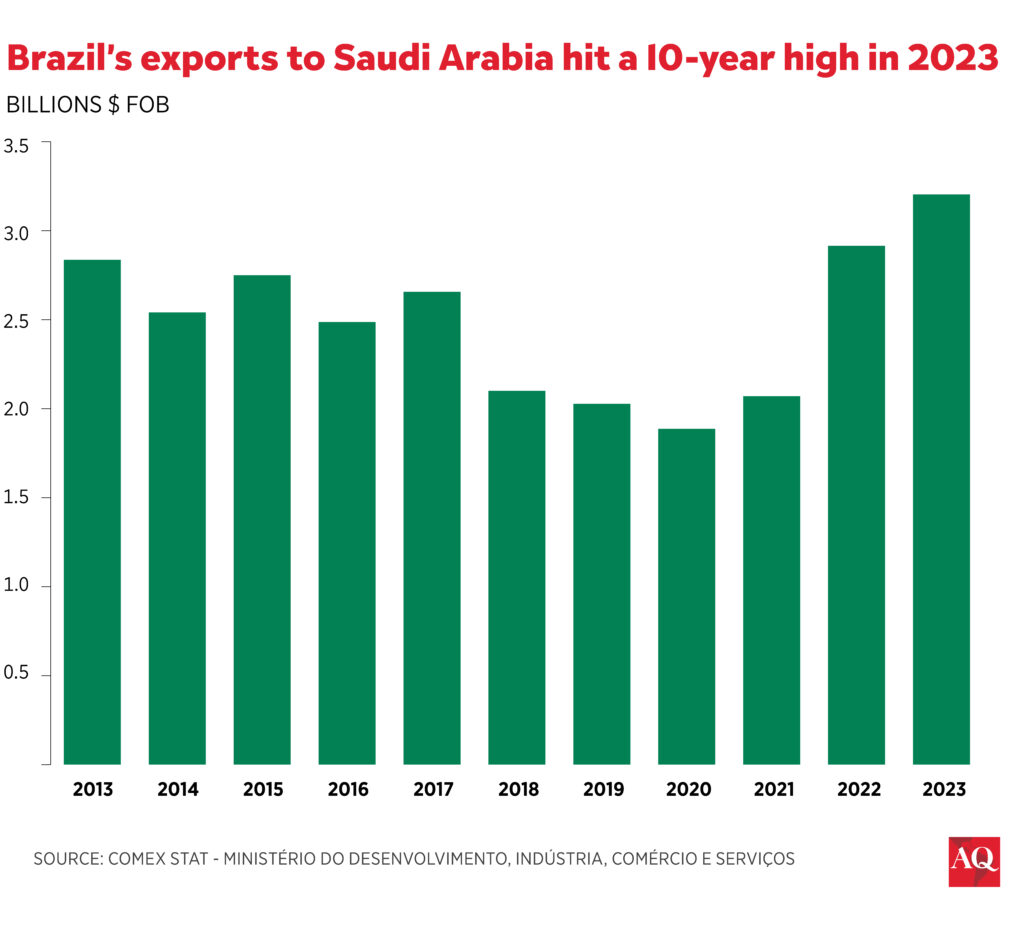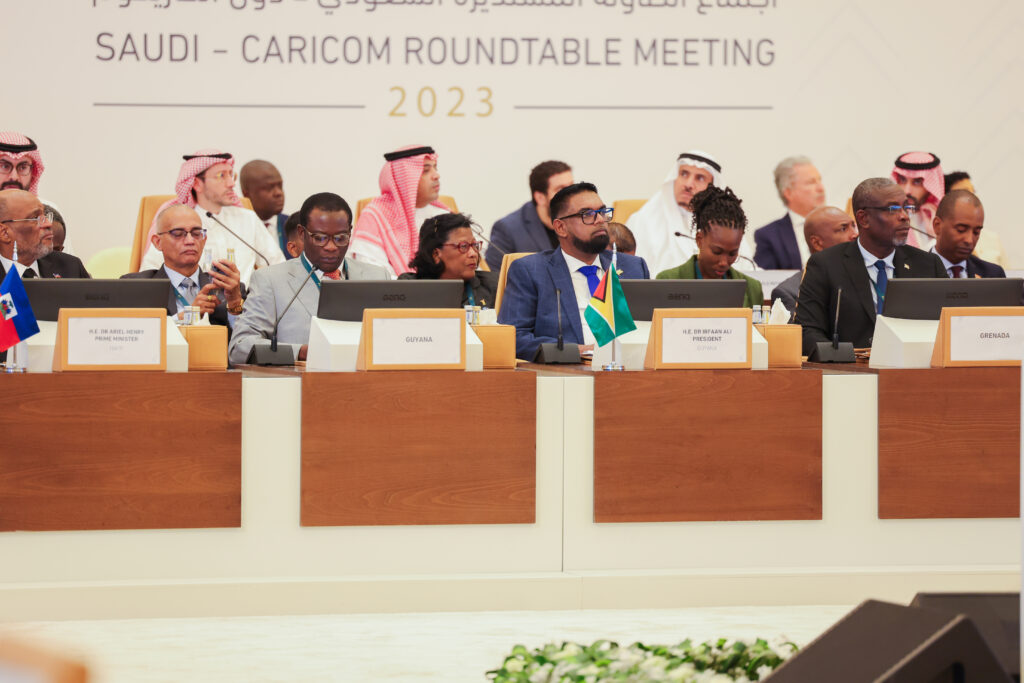Last November, a group of Caribbean dignitaries departed from Barbados and Miami in two private jets headed for Riyadh. Following the inaugural CARICOM-Saudi Arabia Summit, they returned with a $2.5 billion investment commitment for Caribbean development. The pledge, announced by Guyana’s President Irfaan Ali, was one of many outcomes from the high-profile gathering.
The agreement to increase investment in a cash-strapped region came along with the 15-member bloc’s support for Saudi Arabia’s bid to host World Expo 2030, which the kingdom won easily later that month over South Korea and Italy.
Cooperation may play out on an even larger scale as Saudi Arabia seeks further investment opportunities at its first Priority Summit in Latin America from June 11-13 in Rio de Janeiro. The Future Investment Initiative (FII) Institute, whose founding partner is the kingdom’s $925 billion sovereign wealth fund, is set to gather industry leaders, government officials, and several former Latin American heads of state. Earlier this year, the FII Institute also held the second edition of Priority Summit Miami, part of the kingdom’s mission to become a major force in Latin America’s business sphere.
“You see the Saudis being much more aggressive in strengthening ties around the world… and Latin America is certainly part of that,” Gerald Feierstein, former U.S. ambassador to Yemen and current director of the Middle East Institute’s Arabian Peninsula Affairs Program, told AQ.
Accustomed to spending lavishly around the world, Saudi Arabia’s moves in the region have been met without much fanfare but signal broad ambition. The kingdom is considering a production line for some of Brazil’s Embraer airliners and is mulling opening an embassy in Colombia. Aramco, its national oil company, recently acquired a Chilean fuel retailer. And last August, Investment Minister Khalid Al-Falih toured seven nations in the region “with the aim of exploring opportunities to strengthen and deepen investment partnerships.” Like China, India, and the European Union, the kingdom is chasing a more significant footprint in the hemisphere, hoping to secure raw materials, market access and investment opportunities.
Pivoting on its longstanding ties with Brazil while making inroads in other parts of the region, the kingdom’s increasing interest in the Western Hemisphere comes as it pursues Vision 2030, a plan launched in 2016 by Crown Prince Mohammed bin Salman to diversify the economy away from oil and harness investment.
Deepening Brazil ties
Brazil’s relationship with Saudi Arabia started in the 1970s, said Najad Khouri, founding partner and senior researcher at the Grupo de Estudos e Pesquisas sobre o Oriente Médio. Bilateral trade stands at $8 billion, and according to official estimates, it could reach $20 billion by 2030. Last year alone, Brazil’s exports to Saudi Arabia reached $3.2 billion, a 10-year high.

“Latin America is a natural partner [for Saudi Arabia] because it exports vegetable and animal proteins,” Khouri added, emphasizing the kingdom’s high dependence on food imports. Brazil, for example, is the world’s top exporter of halal meat. Last year, the Brazilian food processing company BRF formalized a joint venture with Halal Products Development Company, a subsidiary of Saudi Arabia’s sovereign wealth fund, the Public Investment Fund (PIF).
Saudi Arabia is “deepening trade relations with Brazil in all areas,” Elcineia de Castro, a professor of international relations at Universidade Anhembi Morumbi who focuses on Saudi Arabia, told AQ. “I believe it is a very strategic plan by Saudi Arabia to use Brazil’s resources to feed its national growth plan.”
And the ties between the two countries are anchored by high-level diplomacy seeking a balanced relationship. Last November, while on an official visit to Riyadh, Brazilian President Luiz Inácio Lula da Silva noted that his country was “not just interested in knowing how much Saudi Arabian funds can invest in Brazil, but how much Brazilian entrepreneurs can invest in Saudi Arabia.”
Beyond food, the mining sector is also a priority for the PIF, and Brazilian mining giant Vale recently sold for $2.5 billion 10% of its base metals unit to Manara Minerals, a joint venture between Saudi Arabian Mining Company (Ma’aden) and the PIF. In May, Brazilian aviation company Embraer inked cooperation deals with Saudi Arabia’s National Industrial Development Center and AHQ Group, with the potential for the airplane’s manufacturer to have its airliners built or assembled in Saudi Arabia. Meanwhile, the kingdom is considering opening an investment office in the South American country.
The nations may see further cooperation in the multilateral space. Both are members of the G20, and Brazil will host the G20 Summit in November. More ties have flourished recently as Brazil formally joined the OPEC+ alliance earlier this year—with no binding oil production quotas—and Saudi Arabia was invited to be part of BRICS last August. However, the country has not officially joined yet. The BRICS bloc will meet again in Russia this October.
Global South ambitions
The kingdom is also seeking newer partners in the region. Diversifying the economy and finding “new avenues of jobs for young people” is “the main thrust of Vision 2030. The expansion of their trade ties around the world is an important part of that,” Feierstein said. Vision 2030 is a blueprint for the kingdom’s future as it aims to transform from a petrostate (oil accounts for about 40% of nominal GDP) into a more diversified economy. Job creation is critical, as 63% of Saudis are under 30.

This year, Saudi Arabia’s national oil company made its first downstream retail investment in South America. Aramco acquired Chilean fuel distributor Esmax and opened its first gas station in Chile, with 300 more planned over the next two years. Last June, the Saudi Fund for Development signed loan agreements worth $150 million for bridge and housing construction in Guyana. A member of the Jeddah-based Islamic Development Bank, Guyana has received $235.6 million in financing since 2016. “This is the time for Guyana and CARICOM to find non-traditional partners in pursuit of its development goals,” President Ali said after the Riyadh summit.
With another Saudi Arabia-CARICOM summit planned for 2026, it appears the kingdom will maintain its interest in Latin America and the Caribbean. “With the evolution of the Global South coupled with shared values between Brazil and Saudi Arabia, aligned strategic interests and strong private sectors… why couldn’t we become a top-five investor in each other’s economy?” Investment Minister Al-Falih said at last July’s Brazil-Saudi Arabia Investment Forum in São Paulo.
The approach shows that Saudi Arabia is “thinking regionally,” Castro told AQ. “They don’t just want Brazil, they want all of Latin America close to them… It’s part of their grand plan to later become a leader in the Global South, along with Brazil, India, and other countries that also occupy this position.”






